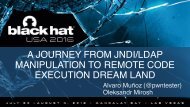Problem
us-16-Weston-Windows-10-Mitigation-Improvements
us-16-Weston-Windows-10-Mitigation-Improvements
Create successful ePaper yourself
Turn your PDF publications into a flip-book with our unique Google optimized e-Paper software.
• S<br />
<strong>Problem</strong>:<br />
Preventative Security<br />
Attackers are agile, adaptive, and results<br />
focused – effective techniques often<br />
don’t map to security boundaries<br />
• Preventative Strategy – SDL “Find all the<br />
bugs” before shipping<br />
• Static Security Boundaries – vulnerability<br />
equals “game over”<br />
• Focus on component level security –<br />
customer assets, configuration, 3 rd party<br />
software largely out-of-scope<br />
• Investigation of exploit and other attack<br />
techniques out-of-scope<br />
• Engineering driven - Focus on<br />
abstraction to support scale and process<br />
• Mitigation design and offensive security<br />
research is ad-hoc and specialized<br />
Market value for exploits is 10x<br />
vulnerabilities – preventative security is<br />
focused on lowest value asset<br />
Attackers invest in developing tool sets<br />
and libraries – no proactive disruption,<br />
reactive response only after attacks<br />
The cost for attackers is unknown – The<br />
current approach to security is abstracted<br />
from attacks – security effectiveness<br />
against real attacks unknown<br />
“Assume breach” mitigation strategy augments preventative security
Strategy:<br />
Analyze<br />
Analyze comprehensive<br />
set of real world data<br />
Identify opportunities<br />
for tactical attack<br />
disruption and future<br />
strategic hardening<br />
Build<br />
Security engineers explore<br />
mitigation concepts with<br />
product owners<br />
Security engineers<br />
prototype or productize<br />
mitigation design<br />
Evaluate<br />
Windows Offensive<br />
Security Research Team<br />
(OSR) evaluates<br />
mitigations and attempts<br />
to identify bypasses<br />
Mitigation flaws are<br />
addressed
Internal Data Sources<br />
External Data Sources<br />
Root Cause<br />
Exploit<br />
Techniques<br />
Exploit Data<br />
Attack<br />
Surface<br />
Mitigation<br />
Impact
# of CVEs<br />
Analysis: High-level vulnerability & exploit trends<br />
450<br />
# of Microsoft RCE/EOP CVEs by patch year<br />
% of Microsoft RCE & EOP CVEs<br />
exploited within 30 days of patch<br />
400<br />
350<br />
300<br />
250<br />
200<br />
150<br />
100<br />
50<br />
0<br />
414<br />
300<br />
287<br />
218<br />
199<br />
155<br />
141<br />
133<br />
121<br />
111<br />
2006 2007 2008 2009 2010 2011 2012 2013 2014 2015<br />
100%<br />
95%<br />
90%<br />
85%<br />
80%<br />
75%<br />
70%<br />
65%<br />
60%<br />
55%<br />
50%<br />
45%<br />
40%<br />
35%<br />
30%<br />
25%<br />
20%<br />
15%<br />
10%<br />
5%<br />
0%<br />
97<br />
24<br />
93 114 130<br />
18 19 25<br />
157<br />
61<br />
156<br />
43<br />
116<br />
25<br />
266 282 396<br />
21 18 18<br />
2006 2007 2008 2009 2010 2011 2012 2013 2014 2015<br />
Patch Year<br />
Patch Year<br />
Total<br />
Linear (Total)<br />
Exploited within 30 days of patch<br />
Not known to be exploited<br />
Vulnerabilities are increasing while evidence of actual exploits is decreasing due to mitigation investments
Percentage of Use<br />
Analysis:<br />
90<br />
80<br />
70<br />
Exploit Techniques used in Public Flash Exploits (2013-2015)<br />
60<br />
50<br />
40<br />
30<br />
20<br />
100%<br />
90%<br />
1<br />
10<br />
0<br />
Primitive :: Arbitrary<br />
Memory RW :: Flash<br />
Vector Length<br />
Corruption<br />
Bypass :: ASLR ::<br />
Predictable Region ::<br />
Heap Spraying<br />
Bypass :: ASLR ::<br />
Predictable Region<br />
Bypass :: DEP :: Code<br />
Reuse :: ROP :: Stack<br />
Pivot<br />
Exploit Technique<br />
Primitive :: Arbitrary Primitive :: Virtual Table<br />
Memory RW :: ByteArray Pointer Overwrite<br />
- DomainMemory<br />
Bypass :: DEP :: Code<br />
Reuse :: ROP :: Allocate<br />
Executable Code ::<br />
VirtualProtect<br />
80%<br />
70%<br />
60%<br />
50%<br />
2<br />
2<br />
1<br />
4<br />
1<br />
Use After Free<br />
Uninitialized Use<br />
Type Confusion<br />
40%<br />
30%<br />
20%<br />
1<br />
4<br />
6<br />
Stack Corruption<br />
Heap Corruption<br />
Arbitrary Corruption<br />
10%<br />
0%<br />
1<br />
1<br />
2013 2014 2015<br />
Exploit technique trend analysis drives new or improved mitigations
Success Story:<br />
0day exploit in Internet Explorer<br />
New Internet Explorer Security Feature<br />
4/23/2014 - 5/1/2014<br />
CVE-2014-1776<br />
6/8/2014<br />
Use-After-Free hardening v1<br />
5/1/2014 - 5/13/2014<br />
2/12/2014 - 3/11/2014<br />
CVE-2014-1815<br />
CVE-2014-0322 2/19/2014 - 3/11/2014<br />
7/6/2014<br />
CVE-2014-0324<br />
Use-After-Free hardening v2<br />
11/7/2014<br />
CFG Windows 8.1 Shipped (Optional Update) 2/11/2015<br />
CFG for Windows 8.1 Shipped (Default)<br />
8/3/2014<br />
Out-of-Date Java Blocking<br />
7/5/2015<br />
Type Protector Shipped<br />
8/18/2015<br />
CVE-2015-2502<br />
10/1/2015<br />
MemGC IE 11<br />
Year<br />
Patched<br />
RCE CVE<br />
Zero Day<br />
RCE CVE<br />
2013 116 8<br />
2014 226 4<br />
2015 188 1<br />
4/1/2014 7/1/2014 10/1/2014 1/1/2015 4/1/2015 7/1/2015 10/1/2015<br />
1/1/2014 1/1/2016<br />
• A focus on mitigations for disruption of invariant techniques used in exploits (ROP, Heap Spraying, UAF)<br />
• In 2015 only 6 days with a zero day Internet Explorer RCE exploit in-the-wild (down from 45, 135)<br />
• Vulnerability volume has increased but number of zero day exploits has decreased
Assume Breach<br />
Prevent Breach<br />
Threat model<br />
Code review<br />
Security testing<br />
Security development lifecycle<br />
(SDL)<br />
• Detection, Containment, Response,<br />
and Recover<br />
Redteams<br />
Assume Breach<br />
War game exercises<br />
Central security monitors<br />
Live site penetration test<br />
Hypothesis: We can use the assume breach approach to model exploitation and<br />
drive mitigations
“Assume Breach”<br />
PWN2OWN & Data Influenced Mitigations<br />
CFG: suppress sensitive APIs<br />
Flash: Eliminate RWX ATL thunks<br />
Junctions: Prevent sandbox processes<br />
from creating NTFS junctions – TH1<br />
Fonts: Move font parsing to user mode<br />
sandbox<br />
Edge: Prevent content processes from<br />
creating child processes<br />
Edge: Enable win32k system call<br />
restrictions<br />
How do we design effective mitigations pro-actively?
REDTEAM:<br />
Model real-world attacks<br />
• Model attacks based on<br />
ecosystem analysis and<br />
threat intelligence<br />
Identify security gaps<br />
• Measure Time-to-<br />
Compromise (MTTC) /<br />
Pwnage (MTTP)<br />
Demonstrate impact<br />
• Break-it-you-bought-it<br />
work with teams to<br />
address issues<br />
• Evaluate the customerpromises<br />
from an attack<br />
perspective<br />
• Provide data sets of<br />
detection-and-response<br />
• Attack the full stack in<br />
production configuration<br />
(software, configuration,<br />
hardware, OEMs)<br />
• Identify invariant<br />
techniques for mitigation<br />
• Simulate a real-world<br />
incident response before it<br />
occurs (process, owners,<br />
messaging)<br />
• Provide detection guidance<br />
for Defenders<br />
Assume Breach: An Inside Look at Cloud Service Provider Security - Russinovich<br />
• Design mitigations to<br />
drive up MTTC/MTTP<br />
metrics<br />
• Enumerate business and<br />
legal risk<br />
• Show business value,<br />
priorities, and<br />
investments needs with<br />
demonstrable attacks
REDTEAM<br />
BLUETEAM<br />
Offensive security modeling is now a core pillar of Microsoft<br />
security strategy
Internet Explorer, Edge, & Chakra<br />
SmartScreen<br />
Visual Studio<br />
Windows & Devices Group (WDG)<br />
Microsoft Security Response Center (MSRC)<br />
& C+E Security<br />
Microsoft Research (MSR)<br />
Dave Buchthal, Shubham Chopra, Crispin Cowan, Bo Cupp, Mike Decker, Jim Fox, Matt Gradwohl, John Hazen, C.J.<br />
Hebert, Forbes Higman, Michael Howell, Sermet Iskin, Rick James, Riff Jiang, Venkat Kudallur, Louis Lafreniere, Curtis<br />
Man, Ed Maurer, Bruce Morgan, Kamen Moutafov, Zach Murphy, Vidya Nallathimmayyagari, Justin Rogers, Todd<br />
Sahl, Saranya Kalpathy Seshadri, Bob Schroder, Kirk Sykora, Jason Weber<br />
Costas Boulis, Ryan Colvin, Jeb Haber, Jeff McKune, Anthony Penta<br />
Natalia Glagoleva, Shayne Hiet-Block, Jim Hogg, Jim Radigan, Asmaa Taha, YongKang Zhu<br />
Patrick Azzarello, Vassil Bakalov, Jasika Bawa, Thorsten Brunklaus, Brandon Caldwell, Eric Douglas, Dustin Duran,<br />
Michael Fortin, Daniel Frampton, Saruhan Karademir, Leif Kornstaedt, Aaron Lahman, Arun Kishan, Ryan Kivett,<br />
Daniel Libby, Niraj Majmudar, Dave Midturi, Cody Nicewanner, Roman Porter, Maliha Qureshi, Jordan Rabet, Vijesh<br />
Shetty, Nathan Starr, Brady Thornton, Prabhakar Hampanna Vrushabendrappa, Landy Wang, David Weston, Arden<br />
White, Arthur Wongtschowski<br />
Chris Betz, Joe Bialek, Tim Burrell, Suha Can, Sweety Chauhan, Vishal Chauhan, Richard van Eeden, Stephen Fleming,<br />
Swamy Shivaganga Nagaraju, Nitin Kumar Goel, John Lambert, Ken Johnson, Matt Miller, Michael Plucinski, Shawn<br />
Richardson, Axel Souchet, Gavin Thomas<br />
Richard Black, Miguel Castro, Manuel Costa, Austin Donnelly
100%<br />
90%<br />
80%<br />
70%<br />
60%<br />
50%<br />
40%<br />
30%<br />
20%<br />
10%<br />
0%<br />
4 6 6 1<br />
3 1<br />
3<br />
4 3<br />
5<br />
3<br />
41 62 11 1<br />
5<br />
1<br />
8 10<br />
3<br />
0 1 2<br />
17<br />
2 3 3<br />
1<br />
29<br />
20<br />
13<br />
10<br />
18<br />
11<br />
3<br />
2<br />
18<br />
18<br />
01 4<br />
9<br />
19<br />
11<br />
1<br />
18<br />
23<br />
12<br />
9<br />
12<br />
15<br />
45<br />
31<br />
24 13<br />
21 30<br />
13 13<br />
102 181<br />
19<br />
31 27 28<br />
133<br />
8 12 11 18<br />
26<br />
2006 2007 2008 2009 2010 2011 2012 2013 2014 2015 2016<br />
Use After Free Heap Corruption Other Type Confusion<br />
Heap OOB Read Uninitialized Use Stack Corruption
1. Allocate object<br />
p = new COptionElement();<br />
// 2. Free object<br />
delete p;<br />
Attacker reallocates p as<br />
a new type<br />
// 3. Use freed object<br />
p->Foo();<br />
// 2. Zero object, but don’t free<br />
ZeroMemory(p, sizeof(T));<br />
// 3. Garbage collection phase<br />
frees all objects with no references<br />
(stack, registers, heap)<br />
Tactic Applies to First shipped<br />
Eliminate entire classes of vulnerabilities Edge on Windows 10 and backported to IE9+ on Windows Vista+ July, 2015 (Windows 10 RTM)
Tactic Applies to First shipped<br />
Eliminate entire classes of vulnerabilities Edge and IE11 on Windows 10 and backported to IE10+ on Windows 7+ July, 2015 (Windows 10 RTM)
No legacy document modes<br />
No legacy script engines (VBScript, JScript)<br />
No Vector Markup Language (VML)<br />
No Toolbars<br />
No Browser Helper Objects (BHOs)<br />
No ActiveX controls 81<br />
Edge<br />
22<br />
34<br />
Internet Explorer<br />
47<br />
0 50 100 150<br />
H1 (Aug 2015 - Jan 2016)<br />
H2 (Feb 2016 - Jul 2016)<br />
Tactic Applies to First shipped<br />
Eliminate entire classes of vulnerabilities Edge on Windows 10 July, 2015 (Windows 10 RTM)
CVE-2003-0344<br />
Trigger stack buffer overrun<br />
Overwrite return address with<br />
predictable address of a “JMP ESP”<br />
Execute shellcode from the stack<br />
Arbitrary native code execution <br />
The Info leak era of<br />
software exploitation<br />
Place array length at a predictable<br />
location (via heap spray/massage)<br />
Modify array length via memory<br />
corruption, enabling arbitrary read/write<br />
Use arbitrary read/write to discover DLL<br />
base address<br />
Construct ROP payload by searching for<br />
code sequences in the DLL<br />
Corrupt C++ virtual table pointer and<br />
trigger virtual method call to first gadget<br />
Execute ROP payload (typically to make<br />
shellcode executable)<br />
Execute arbitrary native code<br />
Escape the sandbox (or operate inside it)<br />
2006 2007 2008 2009 2010 2011 2012 2013 2014 2015 2016
Place array length at a predictable location (via heap spray/massage)<br />
var memory = new Array();<br />
function sprayHeap(shellcode, heapSprayAddr, heapBlockSize) {<br />
var index;<br />
var heapSprayAddr_hi = (heapSprayAddr >> 16).toString(16);<br />
var heapSprayAddr_lo = (heapSprayAddr & 0xffff).toString(16);<br />
while (heapSprayAddr_hi.length < 4) { heapSprayAddr_hi = "0" + heapSprayAddr_hi; }<br />
while (heapSprayAddr_lo.length < 4) { heapSprayAddr_lo = "0" + heapSprayAddr_lo; }<br />
var retSlide = unescape("%u" + heapSprayAddr_hi + "%u" + heapSprayAddr_lo);<br />
while (retSlide.length < heapBlockSize) { retSlide += retSlide; }<br />
retSlide = retSlide.substring(0, heapBlockSize - shellcode.length);<br />
}<br />
var heapBlockCnt = (heapSprayAddr - heapBlockSize) / heapBlockSize;<br />
for (index = 0; index < heapBlockCnt; index++) {<br />
memory[index] = retSlide + shellcode;<br />
}<br />
[1] https://github.com/rapid7/metasploit-framework/blob/master/data/js/memory/heap_spray.js<br />
Tactic Applies to First shipped<br />
Breaking exploitation techniques Edge on Windows 10 July, 2015 (Windows 10 RTM)
Corrupt a C++ virtual table pointer and trigger virtual method call to first gadget<br />
Compile time<br />
Runtime<br />
void Foo(...) {<br />
// SomeFunc is address-taken<br />
// and may be called indirectly<br />
Object->FuncPtr = SomeFunc;<br />
}<br />
Metadata is automatically added to the image which<br />
identifies functions that may be called indirectly<br />
void Bar(...) {<br />
// Compiler-inserted check to<br />
// verify call target is valid<br />
_guard_check_icall(Object->FuncPtr);<br />
Object->FuncPtr(xyz);<br />
}<br />
A lightweight check is inserted prior to indirect calls<br />
which will verify that the call target is valid at runtime<br />
Image<br />
Load<br />
Process<br />
Start<br />
Indirect<br />
Call<br />
•Update valid call target data<br />
with metadata from PE image<br />
•Map valid call target data<br />
•Perform O(1) validity check<br />
•Terminate process if invalid<br />
target<br />
Tactic Applies to First shipped<br />
Breaking exploitation techniques Edge on Windows 10 and IE11 on Windows 8.1+ November, 2014 (Windows 8.1 Update 3)
Return addresses are not protected Valid functions can be called out of context “Fail-open” design for compatibility<br />
Bypass<br />
Non-enlightened Just-in-Time (JIT) compilers<br />
can be abused<br />
Multiple non-instrumented indirect calls<br />
reported to our Mitigation Bypass Bounty<br />
Status<br />
Mitigated in latest version of Edge on Windows 10 (Chakra, Adobe Flash, and WARP)<br />
Mitigated in latest version of Edge on Windows 10<br />
NtContinue/longjmp – mitigated for all CFG enabled apps on Windows 10<br />
Calling sensitive APIs out of context<br />
Corrupting return addresses on the stack<br />
VirtualProtect/VirtualAlloc – mitigated in latest version of Edge on Windows 10<br />
LoadLibrary – mitigated in latest version of Edge on Windows 10 via code integrity<br />
WinExec – mitigated in Edge on Windows 10 anniversary edition via child process policy<br />
Known limitation that we intend to address with new technology (e.g. with Intel CET)
Execute arbitrary native code<br />
Only properly signed images can be loaded<br />
(Microsoft, WHQL, Store, or DRM signed)<br />
Binaries on remote devices (UNC/WebDAV)<br />
cannot be loaded<br />
Example of such an attack provided by Yang Yu @ Black Hat USA 2014<br />
Tactic Applies to First shipped<br />
Breaking exploitation techniques Edge on Windows 10 and opt-in for other apps November, 2015 (Windows 10 1511 update)
Execute arbitrary native code<br />
Code is immutable<br />
Data cannot become code<br />
Code pages cannot become writable via<br />
VirtualProtect or initially allocated as WX<br />
Data pages cannot become executable via<br />
VirtualProtect or initially allocated as WX<br />
Tactic Applies to First shipped<br />
Breaking exploitation techniques Opt-in by process on Windows 8.1+ August, 2013 (Windows 8.1 RTM)
Windows<br />
Hyper Guard<br />
• Prevents modification of key MSRs, control<br />
registers, and descriptor table registers<br />
• Example: SMEP cannot be disabled<br />
Secure Kernel<br />
Hypervisor-Enforced Code Integrity (HVCI)<br />
• Only properly signed kernel pages can<br />
become executable<br />
Robust even if an attacker can perform arbitrary<br />
read/write in VTL0 kernel<br />
https://channel9.msdn.com/Blogs/Seth-Juarez/Windows-10-Virtual-Secure-Mode-with-David-Hepkin<br />
Tactic Applies to First shipped<br />
Breaking exploitation techniques Windows 10 with Hyper-V enabled July, 2015 (Windows 10 RTM)
Non-paged pool<br />
System Page tables cache<br />
Paged pool<br />
Non-paged pool<br />
System cache<br />
Page tables<br />
…<br />
Paged pool<br />
Paged pool<br />
Non-paged System cache pool<br />
Page tables<br />
PML4 Directory ptr Directory Table Offset<br />
System region PML4 entries are<br />
randomized<br />
Non-paged pool<br />
Paged pool<br />
System cache<br />
PFN database<br />
Page tables<br />
… and so on<br />
Page table self-map and PFN database are<br />
randomized<br />
• Dynamic value relocation fixups are used to<br />
preserve constant address references<br />
SIDT/SGDT kernel address disclosure is prevented<br />
when Hyper-V is enabled<br />
• Hypervisor traps these instructions and hides<br />
the true descriptor base from CPL>0<br />
GDI shared handle table no longer discloses<br />
kernel addresses<br />
Tactic Applies to First shipped<br />
Breaking exploitation techniques Windows 10 64-bit kernel August, 2016 (Windows 10 Anniversary Edition)
Mitigation<br />
How to opt-in<br />
Control Flow Guard Compile and link with /guard:cf (requires Visual Studio 2015 Update 2+)<br />
Image load restrictions<br />
• SetProcessMitigationPolicy with ProcessImageLoadPolicy<br />
• UpdateProcThreadAttribute with PROC_THREAD_ATTRIBUTE_MITIGATION_POLICY<br />
Code integrity restrictions<br />
• SetProcessMitigationPolicy with ProcessSignaturePolicy<br />
• UpdateProcThreadAttribute with PROC_THREAD_ATTRIBUTE_MITIGATION_POLICY<br />
Dynamic code restrictions<br />
• SetProcessMitigationPolicy with ProcessDynamicCodePolicy<br />
• UpdateProcThreadAttribute with PROC_THREAD_ATTRIBUTE_MITIGATION_POLICY<br />
Child process restrictions • UpdateProcThreadAttribute with PROC_THREAD_ATTRIBUTE_CHILD_PROCESS_POLICY<br />
HVCI<br />
• Set HypervisorEnforcedCodeIntegrity (REG_DWORD) to 1 in<br />
HKLM\SYSTEM\CurrentControlSet\Control\DeviceGuard<br />
For more information: https://aka.ms/setprocessmitigationpolicy
Win32<br />
Process<br />
Store App<br />
AppContainer<br />
User Mode Font<br />
Driver Host<br />
AppContainer<br />
Manager<br />
AppContainer<br />
Edge<br />
Content<br />
AppContainer<br />
Adobe Flash<br />
AppContainer<br />
Store apps all run within an<br />
AC<br />
Font parsing is now done in<br />
user mode within an AC<br />
System Call Filter<br />
Edge uses a multi-AC design<br />
for isolation<br />
New in Windows 10 Anniversary<br />
Edition<br />
Adobe Flash has now been<br />
moved to its own AC<br />
AppContainer<br />
Properties<br />
Security boundary<br />
Capability-based resource access<br />
Locked down process<br />
Microsoft will address vulnerabilities that can violate AC security boundary<br />
Network, file, registry, and device access are restricted (both read and write)<br />
No symbolic links, reduced attack surface, and various mitigations on by default<br />
Win32k system call filtering is<br />
enabled for Edge<br />
Tactic Applies to First shipped<br />
Containing damage & preventing persistence Multiple applications August, 2012 (Windows 8)
Rapidly<br />
Respond<br />
• Mobilize engineering teams to quickly understand and develop a fix for<br />
a vulnerability<br />
Rapidly<br />
Protect<br />
• Use SmartScreen and other technologies to protect customers from inthe-wild<br />
attacks<br />
• Enable Microsoft Active Protection Program (MAPP) partners to protect<br />
the broader ecosystem<br />
Rapidly<br />
Update<br />
• Broadly deploy and install security updates to quickly minimize the<br />
affected population size
Legend<br />
2/4/2014<br />
CVE-2014-0497<br />
Exploited within 10 days of patch<br />
Exploited as 0day<br />
Exploited within 30 days of patch<br />
4/28/2014<br />
CVE-2014-0515<br />
9/9/2014<br />
CVE-2014-0556<br />
11/15/2014<br />
CVE-2014-9163<br />
1/16/2015<br />
CVE-2015-0310<br />
2/27/15<br />
CVE-2014-4130<br />
2/2/2015<br />
CVE-2015-0313<br />
10/14/2014<br />
1/20/2015<br />
CVE-2014-0569<br />
CVE-2015-0311<br />
11/11/2014<br />
CVE-2014-8440<br />
2/11/2015<br />
CVE-2015-3043<br />
3/20/2015<br />
CVE-2014-0336<br />
5/26/2015<br />
CVE-2015-3090<br />
7/17/2015<br />
CVE-2015-5122<br />
6/16/2015<br />
CVE-2015-3104<br />
6/27/2015<br />
CVE-2015-3113<br />
4/17/2015<br />
CVE-2015-0359<br />
8/29/2015<br />
CVE-2015-5560<br />
7/24/2015<br />
CVE-2015-2419<br />
12/12/15<br />
CVE-2015-8446<br />
7/7/2015<br />
CVE-2015-5119 10/13/2015<br />
12/24/2015<br />
7/21/2015 CVE-2015-7645<br />
CVE-2015-8651<br />
CVE-2015-1671<br />
12/29/2015<br />
CVE-2016-1010<br />
3/18/2016<br />
CVE-2016-4117<br />
3/26/2016<br />
CVE-2016-1001<br />
5/5/2016<br />
CVE-2016-4171<br />
4/4/2016<br />
CVE-2016-1019<br />
Control-flow Enforcement Technology<br />
(CET)<br />
• Indirect branch tracking via<br />
ENDBRANCH<br />
• Return address protection via<br />
shadow stack<br />
Hardware-assists for helping to mitigate<br />
control-flow hijacking & ROP<br />
April 2014 July 2014 October 2014 January 2015 April 2015 July 2015 October 2015 January 2016 April 2016 July 2016<br />
Preview specification:<br />
https://software.intel.com/sites/default/files/managed/<br />
4d/2a/control-flow-enforcement-technologypreview.pdf
The number of Microsoft vulnerabilities exploited within 30 days of a patch has<br />
continued to decline Y/Y despite increases in the number of vulnerabilities being<br />
addressed each year<br />
In the last two years, no zero day exploits for Microsoft RCE vulnerabilities have been<br />
found in-the-wild that work against Internet Explorer 11 on Windows 8.1+<br />
Since releasing Edge one year ago, there have been no zero day exploits found in-thewild<br />
targeting Edge









